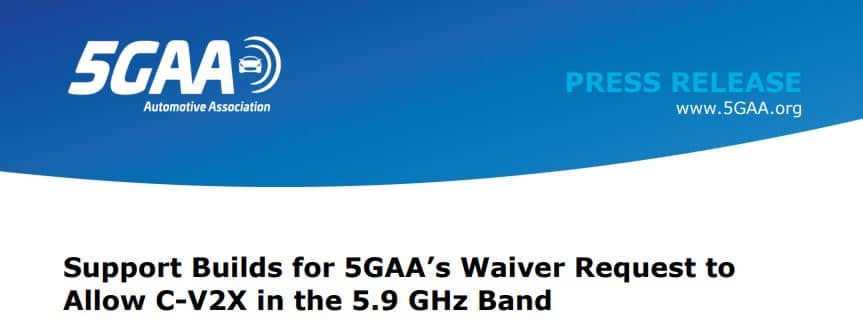
US Support Builds for 5GAA’s Waiver Request to Allow C-V2X in the 5.9 GHz Band
Stakeholders from the automobile, wireless, and technology industries filed comments at the US Federal Communications Commission (FCC) in support of the 5G Automotive Association’s waiver request seeking permission to deploy Cellular Vehicle-to-Everything (C-V2X) technology in a portion of the 5.9 GHz band.
Click here to have a look at the official press release.
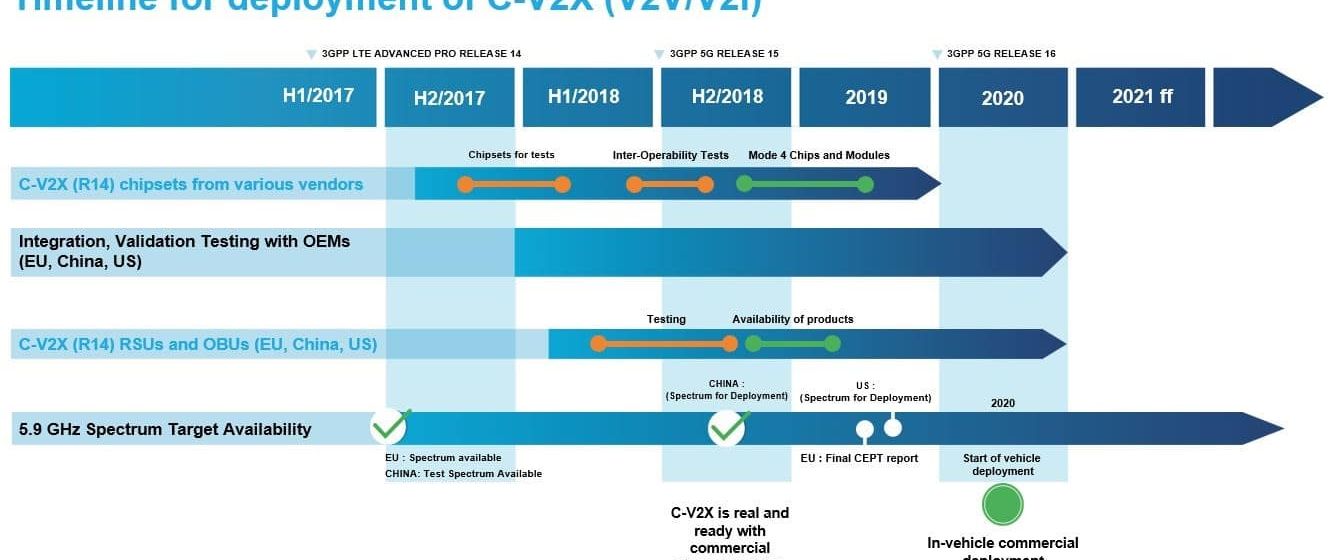
5GAA releases updated white paper on C-V2X Deployment Timeline
In December 2017 5GAA published the white paper “Timeline for deployment of LTE-V2X (V2V/V2I)” focusing on the introduction of direct communications with LTE 3GPP Rel.14. Since then Cellular-V2X (C-V2X) has gained a lot of momentum in the eco-system and we are at the verge of deploying the next generation of mobile network technology – 5G.
This updated timeline of the introduction of C-V2X covers the following topics:
- The extended use of V2N for safety-oriented services in vehicles deployed on the roads
- The comprehensive test and evaluation activities undertaken by the ecosystem consisting of OEMs, tier-1s, chip vendors, road operators, mobile operators as well as their suppliers and test equipment providers
- Outlook on the evolution towards 5G including backward compatibility
- C-V2X use cases for railways and respective test activities
- Progress on regulatory aspects
The inclusion of 2G, 3G and 4G cellular communication technologies (V2N – Vehicle2Network) into vehicles (i.e. “Connected Cars”) has been extremely successful in delivering benefits for the vehicle, the driver, the automaker and other participants in the transportation and emergency services ecosystem.
At present, more than 100 million Vehicles connected to cellular networks (V2N) are on the roads. This V2N connection is used for a wide variety of services including telematics, connected infotainment, real time navigation and traffic optimization, as well as for safety services including automatic crash notification (ACN) such as eCall, the recognition of slow or stationary vehicle(s) and informational alerts for events including traffic jams, road works and other traffic infrastructure related information, inclement weather conditions and other hazardous conditions. Several OEMs[i] share safety related warnings between their vehicles and have started to exchange this information across OEMs using e.g. services from HERE Technologies. Other initiatives to share information by interconnected backend systems are the EU financed projects ‘Nordic Way’, Talking Traffic’ and the ‘Drive Sweden projects. These projects also interconnect Road Traffic Authorities, Road operators, OEMs and smartphone applications to share traffic related info. The current understanding, also based on the European C-ITS Platform Final Report, is that the nature of these warning messages is informational, and the driver is always responsible.
C-V2X is a recent term introduced for cellular technologies optimized for transportation and connected vehicles. In particular, the C refers to both 4G LTE and 5G NR (new radio) releases of specifications, whereas X refers to multiple things’ vehicles may connect with. C-V2X includes both network-based communications that have been in use for decades, such as vehicle-to-network (V2N), as well as a new complementary mode of operation first defined in the 3GPP Release 14 specifications and approved in June 2017, which allows direct communications between vehicles (V2V), as well as between vehicle and road side infrastructure (V2I and I2V) without requiring any cellular network coverage or subscription. It can further support vulnerable road users (e.g. vehicle to pedestrian, or V2P) by integrating the direct communications technology into mobile and other devices. The direct communications functionality is used to specifically support safety critical services to reduce collisions, support automated driving, and improve traffic efficiency. LTE-V2X is the 3GPP nomenclature for direct communications as specified in releases 14 and 15, whereas 5G NR-V2X is from Release 16 onward. 3GPP R14 also added network communications improvements, delivering increased data volumes, managing greater scale of connected devices, and can further reduce latency and provide for higher levels of reliability in V2N. V2N is also technically known as Uu and refers to an endpoint such as a vehicle communicating with network infrastructure over operator licensed spectrum, whereas V2V/V2I/V2P is supported by direct communications operating on the ITS spectrum (e.g. 5.9GHz) and is known technically as PC5.
Click here to read the full version of this updated White Paper.
[i] https://www.autoblog.com/2018/05/07/volvo-cars-volvo-trucks-share-data/?guccounter=1#slide-7324246

Connected car technology: Cellular V2X outperforms DSRC/ITS-G5 in comprehensive tests as mobility industry moves towards 5G
Munich, 9 November 2018: As regulators worldwide are looking into future rules for connected cars technologies, the 5G Automotive Association has conducted tests to compare the performance of 802.11p/DSRC (known in Europe as ITS-G5) and Cellular V2X PC5 radio technologies in delivering V2V (Vehicle-To-Vehicle) safety messages.
The test results show that Cellular Vehicle-to-everything (C-V2X) direct communications technology, consistently – and in many cases overwhelmingly – outperforms 802.11p/DSRC. With a natural evolution path towards the low latency and high bandwidth benefits of 5G NR, C-V2X also demonstrated superior performance in several dimensions, including the following:
- Enhanced reliability over extended communications range;
- Better non-line-of-sight performance; and
- Greater resiliency to interference (e.g. arising from other devices)
These performance advantages are particularly important in the most difficult environments such as non-line-of-sight scenarios (e.g., around a corner, highway queue forming etc.), where resident onboard sensors and radars have certain limitations.
Reliable and timely radio performance is a crucial requirement that all those with a stake in transport safety depend on to deliver critical safety applications. Such test procedures are a prerequisite to comparing the available radio technologies, and the results are very clear: C-V2X direct communications (PC5) performs better. C-V2X is commercially available and reuses the decades’ long investment into protocols and upper layer applications to improve safety, deliver traffic efficiency, and support automated driving.
The design and execution of each experiment were set up to ensure that environmental conditions, radio frequency parameters, system integration details, and physical structures were consistent when comparing 802.11p/DSRC and C-V2X direct communications.
As yet another strong signal about the global momentum behind C-V2X, 5GAA today counts 102 members (40% from Europe, 35% Asia-Pacific and 25% Americas), an increase of 60% since January 2018, quite a movement for a 2-year-old organization.
5GAA brings together the automotive and ICT industry leaders from all world regions among which carmakers, Tier-1 suppliers, mobile network operators, chipset manufacturers, test equipment vendors, telecom suppliers, and traffic signal suppliers in order to continue C-V2X field tests and to accelerate in-vehicle and infrastructure commercial deployments, foreseen beginning in 2019 globally.
Maxime Flament, CTO of the 5G Automotive Association (5GAA) said “these test results demonstrate that C-V2X direct communications, is today’s most cutting-edge technology for connected and automated driving, and the best to finally deliver upon safety and traffic efficiency. Hence why C-V2X ecosystem is growing so rapidly – the 5G Automotive Association has now more than 100 members who all believe in C-V2X as the future of mobility.”
Read the full report here
See the full webinar here
Notes to Editors:
The V2V radio performance tests were conducted by 5GAA members over a period spanning six months from March through September 2018.
Vehicle-to-Everything (V2X) communication is an essential enabler of cooperative, connected and automated mobility that can be supported today by two concurrent technologies: 802.11p (Wi-Fi based) and Cellular V2X (C-V2X).
C-V2X is the family of cellular technologies designed for automotive applications, standardized by 3GPP, the global telecommunications standard development organization.
C-V2X combines on a single technology platform a direct short-range mode operating over ITS spectrum (not requiring any network coverage or subscription) and a long-range mode using traditional cellular networks operating over the mobile network operator licensed spectrum.
The above-mentioned tests were conducted using only the C-V2X direct short-range communication mode without any network involvement.
C-V2X current realization is based on LTE-V2X (3GPP Release 14, completed in March 2017), and will evolve into 5G-V2X (also called 5G New Radio or “5G NR”) to deliver additional capabilities and support new services (as Release 16, to be completed by 3GPP by end 2019).
About 5GAA
The 5G Automotive Association (5GAA) is a global cross-industry organization of companies from the automotive, technology and telecommunications industries (ICT), working together to develop end-to-end solutions for future mobility and transportation services. Created in 2016, the Association is comprised of over 100 members whose mission is to develop, test and promote communications solutions, initiate their standardization and accelerate their commercial availability and global market penetration, to address society’s connected mobility and road safety needs with applications such as automated driving, ubiquitous access to services and integration into smart city and intelligent transportation.
Media Contact:
Marketing and Communications Team
Email: marcom@5gaa.org

5GAA Report shows superior performance of Cellular V2X vs DSRC
The 5G Automotive Association (5GAA) announces the publication of a tests and results report comparing DSRC and Cellular V2X (C-V2X) radio technologies for their suitability to deliver broadcast V2V (Vehicle-To-Everything) safety messages.
The main conclusion of the report confirms that C-V2X significantly outperformed DSRC in various key areas.
Reliable and timely radio performance is a crucial requirement that the transportation safety stakeholder community, including vehicle manufacturers, road infrastructure owner-operators, standardization bodies and regulators depend on to deliver critical safety applications.
The V2V radio performance tests were conducted over a period spanning six months from March through September 2018. The test results reported here are intended to provide this community with an informed basis for making important decisions on the choice of the air interface to deliver standardized messages (e.g., Basic Safety Message or BSM). Therefore, great care was taken in the design, setup and execution of each experiment to ensure that environmental conditions (weather, time of day, temperature), RF parameters (antennas, power, cables), system integration details, and physical setup (track, obstructions, antenna placement) were consistent when comparing DSRC and C-V2X.

5GAA Webinar: Comparing DSRC & C-V2X Technology
On 17 October at 5PM (CET) 5GAA sponsored an exclusive webinar on Talking Cars: Field Test Results Comparing DSRC & C-V2X Technology.
Register here to access the webinar recording
According to World Health Organization figures, more than 1.2 million casualties occur globally as a result of traffic incidents. As vehicles add more sensors to improve safety and advance the readiness of automated driving, vehicle-to-everything communications (V2X) are expected to significantly enhance road safety. As a result, global governments and industry (automotive and telecom) are carefully evaluating two different V2X technologies: IEEE 802.11p-based radio DSRC/ITS-G5 and 3GPP-based C-V2X. 802.11p is an older radio technology, based on specifications dating to 1999, and has been researched over the past decade, whereas C-V2X is a newer radio technology benefiting from many advances in communications.
This 5GAA-sponsored webinar will review how each of the technologies performed in an apples-to-apples comparison, executed by Ford and Qualcomm Technologies, Inc in US lab and field testing.
This webinar agenda included:
- The reliability, communication range and latency of each V2X technology under the same test conditions
- Performance comparison in congested environments
- Resiliency of each technology to adverse deployment conditions, including interference
Speakers:
Steve Bell, Senior Analyst, Heavy Reading
Maxime Flament, CTO, 5GAA
Gautam Savarkar, Senior Director, Engineering, Qualcomm Technologies, Inc
Ivan Vukovic, Technical Specialist, Ford Motor Company
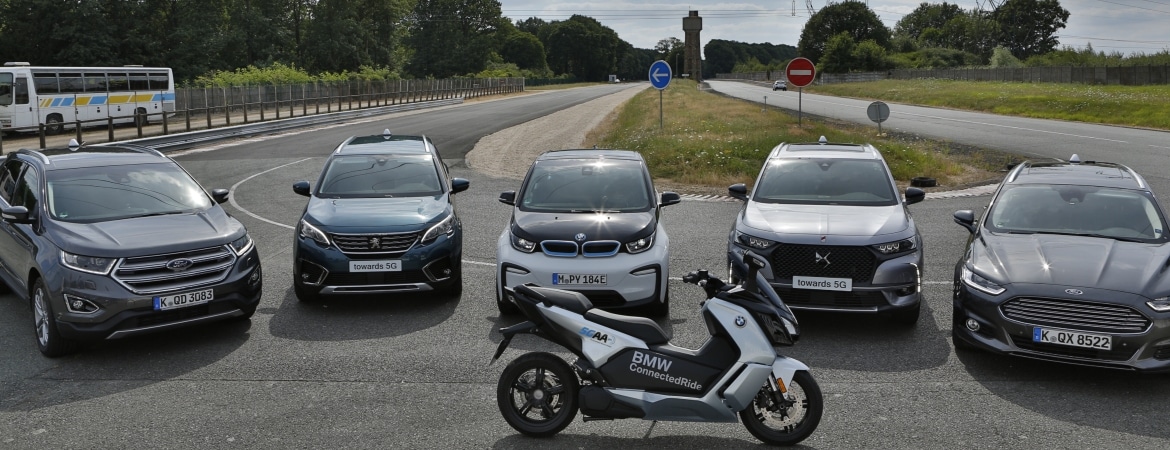
5GAA C-V2X Workshop and Demonstration Paris 2018
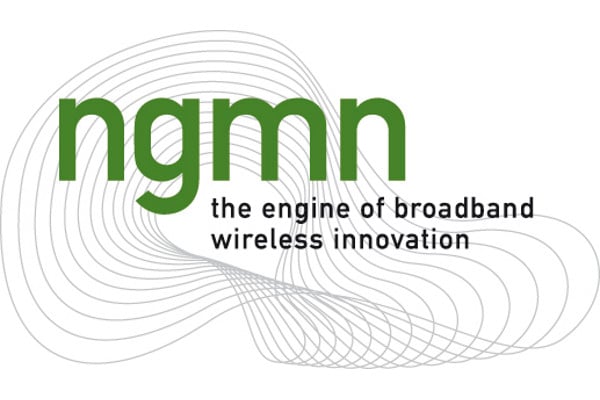
NGMN Publish white paper on V2X
The Next Generation Mobile Networks (NGMN) recently published a White Paper demonstrating their views on Vehicle-To-Everything (V2X) technologies as a key component to reduce the number of road accidents and enhance safety on our roads.
In the study, eight V2X use cases were chosen to reflect the three ITS application types: 1) road safety, 2) traffic management & efficiency and 3) infotainment. They encompassed various C-V2X communication methods such as Vehicle-To-Vehicle (V2V), Vehicle-To-Infrastructure (V2I), Vehicle-To-Pedestrian (V2P), Infrastructure-To-Vehicle (I2V), Vehicle-To-Network-To-Vehicle (V2N2V), and Network-To-Vehicle (N2V).
Here are some of the key findings and conclusions of the NGMN as highlighted in the paper:
- To date, NGMN members have provided cellular connectivity to more than 30 million vehicles worldwide which are used for a variety of safety-related use cases (e.g. distribution safety-related jam warning, black ice warnings, etc.). It is expected that in the near future every vehicle will be equipped with cellular connectivity. This is a good and market-driven basis for further deployment of further C-V2X technology and services.
- With the finalization of 3GPP Rel. 14 specifications at the beginning of 2017, NGMN members now have a 3GPP standardized solution, which supports both long-range as well short-range communication, and which fulfills all the requirements of a C-ITS eco-system.
- After already ongoing tests, the technology will be deployed by 2020.
- NGMN believes that C-V2X is not only able to enhance safety features for vehicles, but also supports use cases for other traffic participants, like pedestrians and cyclists.
- NGMN has investigated and concluded that C-V2X technology is superior to IEEE 802.11p standards, technically, economically, and eco-system wise, and can well satisfy the basic safety applications…

5GAA, BMW Group, Ford and Groupe PSA Exhibit First European Demonstration of C-V2X Direct Communication Interoperability Between Multiple Automakers
- Companies team up with Qualcomm and Savari to showcase C-V2X’s advanced performance for safety, traffic efficiency, and autonomy
- Exhibition includes communication between vehicles, motorcycles, and infrastructure, showing commercial readiness for industry deployments as early as 2020
Downloadable Resources |
Photos |
Infographic |
Soundbite Video Clip |
PARIS — July 11, 2018 – The 5G Automotive Association (5GAA), the BMW Group, Ford Motor Company (NYSE: F), and Groupe PSA — in association with Qualcomm Technologies, Inc., a subsidiary of Qualcomm Incorporated, and Savari, Inc. — announced today Europe’s first live demonstration of C-V2X direct communication technology operating across vehicles from multiple auto manufacturers. The live demonstration also featured a live showcase of C-V2X direct communication technology operating between passenger cars, motorcycles, and roadside infrastructure. C-V2X is a global solution for vehicle-to-everything (V2X) communication in support of improved automotive safety, automated driving and traffic efficiency.
The demonstration exhibited the road safety and traffic efficiency benefits of using C-V2X for Vehicle-to-Vehicle (V2V) collision avoidance, as well as Vehicle-to-Infrastructure (V2I) connectivity to traffic signals and Traffic Management Centers (TMC). C-V2X was operated using real-time direct communications over ITS spectrum and demonstrated its ability to work without cellular network coverage, and underscores its commercial readiness for industry deployment as early as 2020. Superior performance and cost-effectiveness compared to other V2X technologies, along with forward-compatibility with 5G, make C-V2X direct communications a preferred solution for C-ITS applications.
Six demonstrations were shown including Emergency Electronic Brake Light, Intersection Collision Warning, Across Traffic Turn Collision Risk Warning, Slow Vehicle Warning and Stationary Vehicle Warning, Signal Phase and Timing / Signal Violation Warning and Vulnerable Road User (pedestrian) Warning. The vehicles involved included two-wheel e-scooters provided by BMW Group, and automotive passenger vehicles provided by Ford, Groupe PSA, and BMW Group, all of which were equipped with C-V2X direct communication technology using the Qualcomm® 9150 C-V2X chipset solution. V2X software stack and application software, along with roadside infrastructure, were provided by industry leader, Savari.
C-V2X is globally supported by a broad automotive ecosystem, which includes the fast growing 5GAA organization. The 5GAA involves over 90 global members comprised of many leading automakers, Tier-1 suppliers, software developers, mobile operators, semiconductor companies, test equipment vendors, telecom suppliers, traffic signal suppliers and road operators.
Cellular modems will be key to the C-V2X deployment in vehicles to support telematics, eCall, connected infotainment and delivering useful driving/traffic/parking information. As C-V2X direct communication functionality is integrated into the cellular modem, C-V2X solutions are expected to be more cost-efficient and economical over competing technologies, and benefit from accelerated attach rates. C-V2X direct communication field validations are currently underway in Germany, France, Korea, China, Japan and the U.S.
C-V2X currently stands as the only V2X technology based on globally recognized 3rd Generation Partnership Project (3GPP) specifications, with ongoing evolution designed to offer forward compatibility with 5G. C-V2X also leverages and reuses the upper layer protocols defined by the automotive industry, including the European Telecommunications Standards Institute (ETSI) organization. C-V2X includes two complementary transmission modes:
- Direct communication as shown in this demonstration for V2V and V2I use cases
- V2N network communication, which leverages mobile operators for connectivity and delivers cloud-based services, including automated crash notification (ACN, as mandated by eCall), hazard warnings, weather conditions, green light optimal speed advisory (GLOSA), parking spot location, and remote tele-operation to support automated driving, to name a few.
“This demonstration builds on the successful C-V2X showcase we organised with our members Audi, Ford and Qualcomm in Washington DC in April” said Christoph Voigt, Chairman of 5GAA.
“We are excited to witness the growing momentum behind this life-saving technology and to see our members working together to deploy C-V2X, and to make it hit the road as soon as possible.”
“The BMW Group introduced the first C-ITS use cases already in 2013 with the market introduction of the BMW i3. Today most of envisaged C-ITS use-cases are already institutionalized. With the implementation of C-V2X, the BMW Group accomplishes the last set of the puzzle with a practical path to C-ITS showing quick benefits,” said Christoph Grote, Senior Vice President Electronics, BMW Group.
“With its ability to safely and securely connect vehicles, along with its evolution into 5G, C-V2X is integral to Ford’s vision for future transportation in which all cars and infrastructure talk to each other,” said Thomas Lukaszewicz, Manager Automated Driving, Ford of Europe. “We are very encouraged by preliminary test results in Europe and elsewhere which support our belief that C-V2X direct communications has superior V2X communication capabilities.”
“We’re moving forward with seamless communication between cars and their environment for enhancing road safety, as well as our customers’ safety,” said Carla Gohin, Group PSA’s Vice President for Research and Advanced Engineering. “Following the first European C-V2X direct communications demonstration we hosted with Qualcomm Technologies last March, we’re pleased to work with leading automotive and technology companies today to highlight that C-V2X interoperability is a reality.”
“This demonstration of interoperability between multiple automakers is not only another milestone achieved towards C-V2X deployment but also further validates the commercial viability and global compatibility of C-V2X direct communications for connected vehicles,” said Enrico Salvatori, senior vice president & president, Qualcomm Europe, and MEA. “We look forward in continuing to work alongside leaders in the automotive industry, like the 5GAA, BMW Group, Ford, Groupe PSA and Savari, to help advance the automotive industry’s shift towards a safer, connected and more autonomous future.”
“As one of the V2X pioneers, our company is extremely pleased to continue to help enable the next step in the V2X revolution that we helped start back in 2008,” said Ravi Puvvala, CEO of Savari. “For the last year and a half, the Savari team has worked diligently alongside the dedicated C-V2X engineers in the 5GAA partnership. The resulting string of increasingly impressive demonstrations is continuing to convince the world that C-V2X will soon be deployed around the world.”
About 5GAA
The 5G Automotive Association (5GAA) is a global cross-industry organization of companies from the automotive, technology and telecommunications industries (ICT), working together to develop end-to-end solutions for future mobility and transportation services.
Created in 2016, the Association is comprised of over 90 members whose mission is to develop, test and promote communications solutions, initiate their standardization and accelerate their commercial availability and global market penetration, to address society’s connected mobility and road safety needs with applications such as automated driving, ubiquitous access to services and integration into smart city and intelligent transportation. For more information, visit 5GAA’s website, LinkedIn and Twitter pages.
About the BMW Group
With its four brands BMW, MINI, Rolls-Royce and BMW Motorrad, the BMW Group is the world’s leading premium manufacturer of automobiles and motorcycles and also provides premium financial and mobility services. The BMW Group production network comprises 30 production and assembly facilities in 14 countries; the company has a global sales network in more than 140 countries. In 2017, the BMW Group sold over 2,463,500 passenger vehicles and more than 164,000 motorcycles worldwide. The profit before tax in the financial year 2017 was € 10.655 billion on revenues amounting to € 98.678 billion. As of 31 December 2017, the BMW Group had a workforce of 129,932 employees. The success of the BMW Group has always been based on long-term thinking and responsible action. The company has therefore established ecological and social sustainability throughout the value chain, comprehensive product responsibility and a clear commitment to conserving resources as an integral part of its strategy.
Facebook: https://www.facebook.com/BMWGroup
Twitter: https://twitter.com/BMWGroup
YouTube: https://www.youtube.com/BMWGroupview
Google+: https://googleplus.bmwgroup.com
About Ford Motor Company
Ford Motor Company is a global company based in Dearborn, Michigan. The company designs, manufactures, markets and services a full line of Ford cars, trucks, SUVs, electrified vehicles and Lincoln luxury vehicles, provides financial services through Ford Motor Credit Company and is pursuing leadership positions in electrification, autonomous vehicles and mobility solutions. Ford employs approximately 202,000 people worldwide. For more information regarding Ford, its products and Ford Motor Credit Company, please visit www.corporate.ford.com.
About Groupe PSA
Groupe PSA designs unique automotive experiences and delivers mobility solutions to meet all customer expectations. The Group has five car brands, Peugeot, Citroën, DS, Opel and Vauxhall and provides a wide array of mobility and smart services under the Free2Move brand. Its ‘Push to Pass’ strategic plan represents a first step towards the achievement of the Group’s vision to be “a global carmaker with cutting-edge efficiency and a leading mobility provider sustaining lifetime customer relationships”. An early innovator in the field of autonomous and connected cars, Groupe PSA is also involved in financing activities through Banque PSA Finance and in automotive equipment via Faurecia. Find out more at groupe-psa.com/en
Media library: medialibrary.groupe-psa.com / @GroupePSA_EN
About Qualcomm
Qualcomm invents breakthrough technologies that transform how the world connects and communicates. When we connected the phone to the Internet, the mobile revolution was born. Today, our inventions are the foundation for life-changing products, experiences, and industries. As we lead the world to 5G, we envision this next big change in cellular technology spurring a new era of intelligent, connected devices and enabling new opportunities in connected cars, remote delivery of health care services, and the IoT — including smart cities, smart homes, and wearables. Qualcomm Incorporated includes our licensing business, QTL, and the vast majority of our patent portfolio. Qualcomm Technologies, Inc., a subsidiary of Qualcomm Incorporated, operates, along with its subsidiaries, all of our engineering, research and development functions, and all of our products and services businesses, including, the QCT semiconductor business. For more information, visit Qualcomm’s website, OnQ blog, Twitter and Facebook pages.
About Savari
Savari seeks to make the world’s roadways and vehicles automated and safer by deploying advanced wireless sensor technologies and software. Savari builds software and hardware sensor solutions for automotive car manufacturers, the automotive aftermarket and smart cities. The company pioneered V2X radio technology, which is crucial for vehicles to achieve Level 4 and Level 5 of automation. The technology allows vehicles to share data with other vehicles, traffic lights and smartphones. With more than 150 man-years of V2X learning and development and 15 million-plus miles per year of public testing, Savari is a leader in V2X technology. Savari is headquartered in Santa Clara, Calif., and has offices in Detroit, Mich., Munich, Germany, Seoul, Korea and Bengaluru, India. For more information, visit savari.net.
###
Qualcomm is a trademark of Qualcomm Incorporated, registered in the United States and other countries. Other product and brand names may be trademarks or registered trademarks of their respective owners.
Qualcomm 9150 C-V2X chipset is product of Qualcomm Technologies, Inc. and/or its subsidiaries
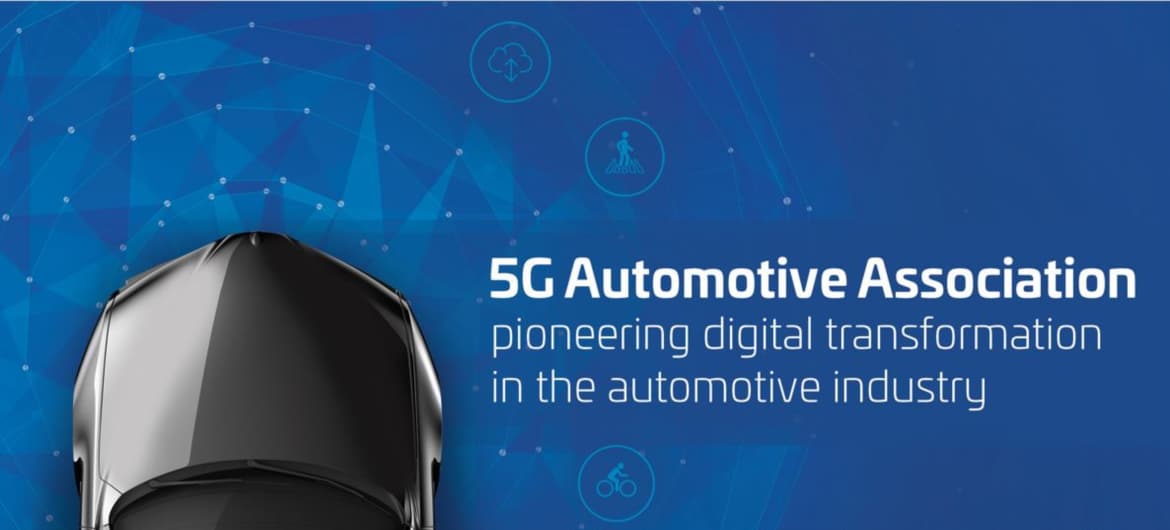
5GAA C-V2X Workshop and Demonstration
On 10 July in Paris, The 5G Automotive Association (5GAA) organised a Workshop with the support of PSA Groupe, Ford, BMW to present and showcase Cellular-Vehicle-to-Everything (C-V2X) technology to European transport stakeholders including EU Member States Ministries, Road Traffic Authorities & Road Operators, as well as a wide array of interest groups and industry representatives. The Workshop was followed by a Demonstration of C-V2X Direct Communication Interoperability Between Multiple Automakers (BMW Group, Ford, and Groupe PSA).
With the support of UTAC-CERAM, this interactive Workshop and Demonstration was intended to advance the dialogue between automakers, technology providers, mobile network operators and the overall transportation community on the capabilities, timeline and deployment models for Cooperative Intelligent Transport Systems (C-ITS) in Europe. This event also showcased the most recent developments and deployment initiatives around C-V2X, paving the way towards 5G for the uptake of Cooperative, Connected and Automated Mobility (CCAM).
The presentations made during the workshop are downloadable here below:
- 5GAA Opening – 5GAA
- The Automotive Value Proposition of Cellular-V2X – BMW Group
- Future-Proof Infrastructure: Planning & Executing Technology Transition – Commsignia
- Now, Near and Far: The Case For C-V2X – Ford Motor Company
- Why C-V2X: A Global OEM Perspective – PSA Groupe
- Leveraging Mobile Network Infrastructure for C-ITS – Orange
- Synergies in Connected Mobility of Tomorrow: C-V2X & Railways Case Study – SNCF
The presentations made during the demonstration are downloadable here below:
- 5GAA Opening – 5GAA
- C-V2X Direct Communications Multi-Vehicle Interoperability – PSA Group, BMW, Ford, Savari, Qualcomm

5GAA Supports Accelerated Deployment of C-V2X in China at MWC Shanghai 2018
28 June, Shanghai, China – The 5G Automotive Association (5GAA), with the strong support of the telecommunications and automotive industries and senior Chinese government officials, presented the latest progress to deploy Cellular-Vehicle-To-Everything (C-V2X) on China’s roads, as well as across the globe, leading the efforts to deliver future connected mobility solutions. The discussion took place during a 5GAA roundtable at the Mobile World Congress in Shanghai.
China’s government officials support immediate deployment of C-V2X
China has been a trailblazer in adopting C-V2X, remaining at the global forefront of rolling out the technology. At the 5GAA “Connected Mobility in Action” roundtable, Ce Zhao, Director of High-Tech Department of Science & Technology Division of MIIT, delivered a keynote address on China’s strong commitment in ensuring the investment, testing, and development of C-V2X. Mr. Zhao announced China’s initial spectrum planning for LTE-based C-V2X in 5905~5925MHZ, and provided updates on the country’s national industry strategy, onsite testing, and deployment plan, as well as the country’s national level cooperation for C-V2X.
The Ministry of Transport’s (MOT) Vice Director of Research Institute of Highway, Mr. Lin Wang, also made a presentation providing updates on China’s intelligent highway progress, as well as test environments and scenarios.
Mr. Zhiqin Wang, Vice President of the China Academy of Information and Communications Technology (CAICT) and Chairman of IMT 2020 highlighted the fruitful progress on China’s standards, test framework and verification plan for C-V2X, stating, “Both standard and industry progress shows China’s readiness for full-scale deployment of C-V2X.”
Strong engagement from industry stakeholders as well
China’s industry stakeholders are also strongly committed to making C-V2X on roads a reality. Leading telecommunications and automotive companies in China are conducting product testing to prepare for the commercial deployment of C-V2X. With commercial chipsets ready to hit the road and various demonstration in the making this year, the path towards the deployment of C-V2X is imminent.
Dr. Dang Xiang, Deputy General Manager of Research and Advanced Technology Department at SAIC Motor and Alternate Board Member of 5GAA, presented during a keynote speech the latest industry advances for the deployment of the technology, including the current leading development of C-V2X and architecture of future mobility with the fusion of internet, transportation and vehicles based on C-V2X.
“SAIC Motor is currently transforming from the traditional OEM to the green smart mobility service provider. C-V2X is one of the key technologies to future mobility and SAIC Motor will cooperate with other C-V2X eco-system partners to accelerate the commercialization of C-V2X,” said Dr. Dang Xiang.
In addition to the progress made at a corporate level, companies such as SAIC Motor and China Mobile have been actively involved in 5GAA in developing the framework, required standards, and the business case for C-V2X and 5G future connected mobility services.
“China Mobile is proud to be part of the 5G Automotive Association. We are an active member of the association and strongly believe that by collaborating with the World’s largest Telecommunications and Automotive companies under the same roof, we will create solutions that will better address society’s transport needs and will help pave the way for a more connected mobility World,” said Gang Huang, Vice President of China Mobile Government and Enterprise Service Company.
Accelerating the deployment of C-V2X around the globe
C-V2X presents an unprecedented opportunity: the ability for vehicles to share real-time safety information and “communicate” with other vehicles, pedestrian, city infrastructure, and the networks will ultimately make transportation safer and more enjoyable.
5GAA member companies demonstrated the many benefits of C-V2X during an exciting panel discussion. The panel was comprised of: Julius Marchwicki, Director, Asia-Pacific, Connected Vehicles and Services at Ford Motor Company; Luke Ibbetson, Senior Director of Vodafone and member of the 5GAA Board; Thierry Klein, Head of Disruptive Innovation Program at Nokia Bell Labs and Vice Chair of the 5GAA Board; and Ed Tiedemann, SVP of Engineering, Qualcomm Technologies, Inc.
All panelists shared their views on the current challenges, opportunities, and next steps in the continued development of C-V2X in other regions such as Europe and North America. They also discussed how C-V2X and its evolution to 5G will play a critical role across the automotive and other industries.
Ed Tiedemann, SVP of Engineering, Qualcomm Technologies, Inc. discussed C-V2X trials in the US. He presented the C-V2X direct communication demonstration organised with 5GAA, Audi, Ford and Qualcomm Technologies this April in Washington D.C. The demonstration showcased the benefit of using C-V2X real-time direct communications for vehicle-to-vehicle (V2V) collision avoidance and vehicle-to-infrastructure (V2I) for improved road safety and traffic efficiency by using 3GPP Release 14 C-V2X direct communications and upper layers as developed by SAE to transmit messages in support of six use cases.
“C-V2X is ready for deployment: China is giving the green light, now it is up to the other regions to accelerate as well,” concluded the panel moderator, Dr. Maxime Flament, Chief Technology Officer of 5GAA.
5GAA provider of a platform for debate for key stakeholders
5GAA presence at this year’s MWC Shanghai last week was successful in outlining the association’s vision in being a global player in facilitating thought leadership platforms for relevant stakeholders driving towards building a better mobility ecosystem.
Join the connected mobility conversation on Twitter @5GAA_Official


